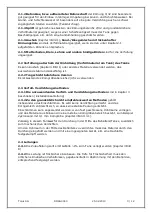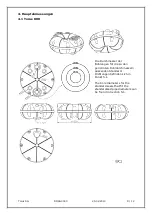
Torus SG
DOSG0040
25.02.2013
4 / 12
1. Location
1.1 Position in relation to buildings
The excavated pit should not be located within a minimum distance from a building, see
Section 3, Image 1. A structure may only be built over the tank if the loads during
construction do not exceed the traffic loads.
1.2 Traffic conditions
Load class A15 (pedestrians, cyclists): no special equipment required.
Load class B (passenger cars, minibus, maximum axle load – 2.2 tonnes) Minimum
distance from the top of the tank to the ground surface: 600 mm Additional information
is provided in the technical documentation for the DN 300 Professional Shaft Extension.
1.3 Ground conditions
The tanks may only be submerged up to the top of the tank (“shoulder height”; see
illustrations in Section 4) in ground water or a high water table. The installation depth
must be at least half as deep as the immersion depth in the ground water / high water
table (negative buoyancy).
With suspended (“liquefied”) clay soil, the immersion depth may not exceed 150 mm.
1.4 Slopes
The soil in the area must be inspected and checked for stability (DIN 1054 Edition
1/2003, E DIN 4084 Edition 11/2002) and stabilised with a retaining system (i.e. a wall)
if necessary. Additional information is available from local public authorities and
construction companies.
1.5 Excavation
In firm, compact soil with an excavation pit up to 1.75 m deep (measurement A3 in
figure 2 and 15a and 15b in Section 3), no angle of repose is necessary. The working
area should be wide enough so that the filling material can be compacted (200 mm in
Figure 2 in Section 3). For depths larger than 1.75 m, a 500 mm working area must be
maintained; the tank is to be surrounded by a layer of backfill material at least 300 mm
thick (Figure 15b in Section 3).
For loose soils (coarse sand, gravel), the information above applies for an excavation pit
depth of 1.25 m or larger (Figure 15a Section 3).
Even when the working area width measures 500 mm, the installation steps illustrated in
Section 3 in images 3 to 13 as well as the illustrations 14, 15a and 15b must be
followed.
1.6. Additional criteria
Any existing cables, pipes, vegetation or other special features present must be taken
into account so as to avoid any possible impairments or risks. The soil above the top of
the tank (Section 4) may be up to 1.5 m deep.
2. Underground installation
2.1. Backfilling material around the tank
Bedding/encasement: Section 3
The backfilling material must be compactable and permeable to water, it must create a
solid compaction and be free of sharp objects which may damage the surface of the tank.
If the backfilling material includes pieces with sharp or pointed edges, the tank surface
must be protected with a sand coating.
2.1.1
Sand and gravel mixtures
(SW and GW in accordance with DIN 18196 and ENV
1046) are the least expensive backfilling materials, because they have a grading curve
that includes many different particle sizes, even with a small amount of fine particles
(fine particles: less than Ø 0.06mm). From a mesh size of the smallest particles
(simplified Ø) to a mesh size of the largest particles: for example 0/32, 2/16, 2/8, 2/32,
or 4/16.






























